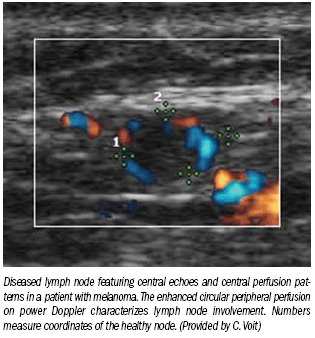- AI
- Molecular Imaging
- CT
- X-Ray
- Ultrasound
- MRI
- Facility Management
- Mammography
Ultrasound aids restaging of melanoma
Researchers in Germany and the Netherlands have discovered ultrasound-based patterns that can accurately diagnose the presence and stage of metastases in patients with melanoma.
Researchers in Germany and the Netherlands have discovered ultrasound-based patterns that can accurately diagnose the presence and stage of metastases in patients with melanoma.
Surgical biopsy of the sentinel lymph nodes (SLNB) remains the standard of care for restaging of suspected metastatic spread from melanoma, but the practice is controversial. Besides the burden and cost of the procedure-which includes preoperative lymphoscintigraphy, intraoperative gamma tracking, and blue dyeing-SLNB is unnecessary in the 80% of patients who never show sentinel node involvement. It also carries the potential for serious side effects, such as chronic inflammation and seroma.
Ultrasound provides a safer, noninvasive, and more cost-effective alternative that could lead to a significant reduction in the number of sentinel node surgical biopsies, said principal investigator Dr. Christiane Voit, chief of the Skin Cancer Center’s diagnostic unit at the Charité Medical University of Berlin.
“The patients [are spared] one operative procedure and go directly to the curative treatment,” Voit told Diagnostic Imaging.

The study is the product of an eight-year-long collaboration between Charité, the Daniel den Hoed Cancer Center at Erasmus University in Rotterdam, and the department of medical oncology at the Armed Forces Hospital in Ulm, Germany. Voit and colleagues have thus far prospectively enrolled 850 melanoma patients. Of these, 400 have already completed sonography, conventional SLNB as the reference standard test, and an average of nearly four years of follow-up. Patients with suspicious sonography findings also underwent ultrasound-guided fine-needle biopsy.
The investigators found ultrasound patterns that provided consistent signs of early- and late-stage metastatic disease. These signs could also accurately appraise tumor burden before surgical biopsy in up to 90% of cases. Voit released findings at the 2009 European Cancer Organization meeting, held jointly with the European Society for Medical Oncology meeting.
A balloon-shaped ultrasound pattern, with or without central echoes, appeared exclusively in cases of advanced metastasis, Voit said. Peripheral perfusion, on the other hand, suggested mostly an early sign of angiogenesis. These criteria can reliably track down involved lymph nodes at earlier and later stages of their involvement and can be applied by everyone with the proper training and experience, Voit said.
“The future idea would be that only patients with suspicious US examination but unsuccessful fine-needle aspiration cytology would undergo SLNB,” she said. “That would reduce costs and side effects.”
The Reading Room: Racial and Ethnic Minorities, Cancer Screenings, and COVID-19
November 3rd 2020In this podcast episode, Dr. Shalom Kalnicki, from Montefiore and Albert Einstein College of Medicine, discusses the disparities minority patients face with cancer screenings and what can be done to increase access during the pandemic.
